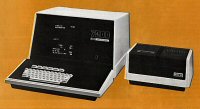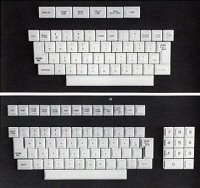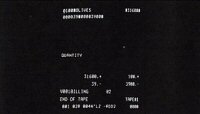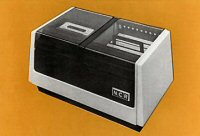|

The NCR 7200 Model I Data Entry Terminal provides a practical, efficient means of transcribing information directly from source documents to magnetic input media. Data entered through the terminal keyboard is recorded on NCR digital data cassettes in ANSI-standard format for subsequent processing, eliminating many intermediate steps and reducing the possibility of human error. Each character entered is displayed on a 9-inch CRT screen having four (standard) or eight (optional) lines of 32 data characters each. The lower portion of the screen is reserved for operator guidance messages, error alerts, and permanent system and I/O status displays. means of transcribing information directly from source documents to magnetic input media. Data entered through the terminal keyboard is recorded on NCR digital data cassettes in ANSI-standard format for subsequent processing, eliminating many intermediate steps and reducing the possibility of human error. Each character entered is displayed on a 9-inch CRT screen having four (standard) or eight (optional) lines of 32 data characters each. The lower portion of the screen is reserved for operator guidance messages, error alerts, and permanent system and I/O status displays.
Data may be entered end verified according to multilevel formats that are programmed to individual user requirements. Each level corresponds to a single cassette record and the number of levels for a given format is limited only by terminal memory size and the number of fields in a level. Linkage from one level to another may be automatic or controlled by the operator. Within a level, fields are defined by number, name, length, and field and data type. Additional parameters may specify entry requirements (must enter at least one character, must fill, may be skipped, etc.), verification requirements, and up to twenty-three combinations of arithmetic operations for each field. Arithmetic operations can include check-digit generation and verification according to one of four optional formulas, addition to or subtraction from one, two, or four optional accumulators, and transferring or transferring and clearing accumulator contents. Fields may also be programmed for automatic skipping or duplication during data entry and verification and for automatic justification with zero- or space-fill.
Data may be verified according to any user-defined format. During verification, source data is rekeyed for comparison with the original entry on a character-by-character basis. If an error is discovered in the original data, the operator has the option of correcting one character or of rekeying the entire field.
Cassettes can be searched for end-of-data, for the end of a batch, for a specific record in numeric sequence, or for a specific record that has been rekeyed. As a featured option, the terminal can be modified to search for a specific record based upon a 1-to 20-character key indexed by the operator.
As a further option, data recorded on cassette can be transmitted to another NCR 7200 or to a central processor over dedicated or switched lines.
Keyboards
Two keyboards are available to simplify transition to the Model I from current data entry equipment. One is patterned after the traditional card punch keyboard; the other, for operators who do not have key-punch experience, is a standard typewriter keyboard. The typewriter keyboard has a numeric pad to expedite entry of all-numeric data. This pad is optional with the card punch keyboard. I from current data entry equipment. One is patterned after the traditional card punch keyboard; the other, for operators who do not have key-punch experience, is a standard typewriter keyboard. The typewriter keyboard has a numeric pad to expedite entry of all-numeric data. This pad is optional with the card punch keyboard.
Terminal control keys are used to shift the keyboard into any of five operational modes (alpha, numeric, function, keyboard release, multicode), to control cursor and tape movement, to correct erroneous entries, to skip or duplicate fields, end to zero- or space-fill unused character positions. In the function shift mode various character keys act as virtual control keys, extending terminal flexibility without making the keyboard complex. Whenever the operator selects this mode, the current CRT display is temporarily replaced with a table of virtual key functions. The multicode mode permits data to be entered in 7-bit absolute code characters in hexadecimal format.
CRT Display
The terminal’s CRT monitor keeps the operator informed of system status , peripheral selection and buffer and accumulator contents. A portion of the screen is reserved for operator guidance and error alert messages that simplify training and guarantee data integrity at the point of entry. Whenever operator intervention is required, terminal firmware displays an appropriate prompting message. If the operator must make a choice, the permissible response keys are also indicated. The operator always has the option of overriding messages; in those instances where a choice is required, one alternative is automatically selected by default if the choice is overridden. An option permits operator lead-through messages to be formatted and displayed on the bottom portion of the screen. , peripheral selection and buffer and accumulator contents. A portion of the screen is reserved for operator guidance and error alert messages that simplify training and guarantee data integrity at the point of entry. Whenever operator intervention is required, terminal firmware displays an appropriate prompting message. If the operator must make a choice, the permissible response keys are also indicated. The operator always has the option of overriding messages; in those instances where a choice is required, one alternative is automatically selected by default if the choice is overridden. An option permits operator lead-through messages to be formatted and displayed on the bottom portion of the screen.
If terminal logic detects an error or malfunction, the screen image begins pulsing at three cycles per second to attract the operator’s attention. When this occurs, the operator presses the keyboard release function key, and the current display is replaced by a message describing the nature of the error.
User-defined delimiter characters appear between all fields on the display for the operator’s convenience. Any displayable character may be defined as a field delimiter and may or may not be recorded on cassette, at the user’s option.
Cassettes
Data output from the Model I is stored on ANSI/ECMA standard digital data cassettes. Compact, easy to store, and inexpensive to transport, each 2.1/2 by 4 inch cassette can contain the same amount of data as a box of punched cards or a 2500 foot roll of punched tape. digital data cassettes. Compact, easy to store, and inexpensive to transport, each 2.1/2 by 4 inch cassette can contain the same amount of data as a box of punched cards or a 2500 foot roll of punched tape.
NCR cassettes are manufactured to exacting quality assurance standards and are pretested to ensure reliability. Write-enable tabs protect recorded data from accidental erasure, and specially constructed, impact-resistant storage cases provide complete environmental protection. The operator can load or unload the cassette without ever having to touch the tape surface.
General Specifications
Standard
Dimensions: Keyboard Display Cassette Handler
- Height 3.25 in. (82,55 mm) 12.00 in. (304,8mm) 6.19 in. (157,2 mm)
- Width 19.00 in. (482,6 mm) 19.00 in. (482,6 mm) 12.75 in. (323.8 mm)
- Depth 8.50 in. (215.9 mm) 14.75 in. (374,8 mm) 8.25 in. (209,6 mm)
CASSETTE CHARACTERISTICS
Speed:
- 7.5 inches/sec. (190 mm/sec.) forward or reverse during read, write, or search.
Capacity:
- Standard - 1300 128-character records per side;
- Optional — 900 256 character records per side;
- 12 inch (30 mm) interrecord gaps.
Recording Density: 800 bpi; Manchester encoding.
Rewind Time: Approximately 90 seconds.
ENVIRONMENTAL STANDARDS
Temperature:
- Operating: 50°F (10°C) to 95°F (35°C);
- Storage: -40°F (-10°C) to 150°F (66°C).
Humidity:
- Operating: 20% to 80% (Max. wet bulb temperature of 70%) without condensation;
- Storage: 5% to 95% without condensation.
Altitude: 980 to 9850 feet (-300 to 3000 metres).
Options
A number of hardware and software options are either already available or under development to broaden the range of terminal applications.
Options currently available are:
- A 256-character data buffer that doubles standard capacity;
- A non-blinking CRT cursor;
- One, two, or four 14-digit, signed accumulators for maintaining totals;
- A second cassette transport that allows tape duplication, record insertion, and dual-cassette verification;
- An NCR 260 receive-only thermal printer that can be attached to the terminal to provide a permanent copy of input data;
- An expanded memory module that increases format memory by 512 bytes;
- A numeric pad with period or comma punctuation (standard with typewriter keyboard);
An extended character set (typewriter keyboard only) that increases the number of discrete display characters from 64 to 128, including upper- and lower case alpha characters;
- The ability to search tape for a specific record based upon a 1- to 20-character key entered by the operator;
- A communications option that permits data recorded on cassette to be transmitted between terminals or from terminals to a central computer;
- The ability to program operator lead-through messages for display;
- Four formulas for check-digit generation and verification (product-add, product-digit-add double-add-double, and account number-divided-by-modulus) with user programmable weights and moduli. Up to three generation and verification schemes may be resident in the terminal at one time.
|

